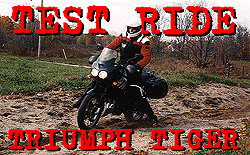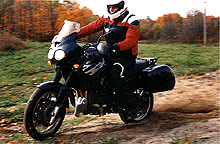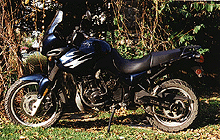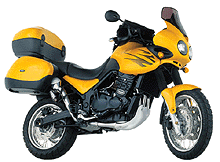|
|
||||||||||||||||||||||||||||||||||||||||
|
TRIUMPH TIGER
INTRODUCTION In typical CMG lazy fashion, we realised that by tying in a comparison test of the new Tiger and BMW R1150GS, we could not only make the piece a two parter, but also reuse something that we've already written. Thus, this week we're posting a run down of the new Triumph Tiger only, with a related part next week, where we'll talk a bit about the trip and go over our comparison conclusions between the two bikes. So for now let's look at the Triumph Tiger. If you want to have another look at the R1150GS run down, then click here.
One of the original models to come out of the Triumph factory, the first generation Tiger went on sale in England in 1993, with the first Canadian sale being in '94. The model remained essentially unchanged until 1999, when it got a complete redesign, with a new engine from the old T509 (retuned for lower umph), a new tubular steel perimeter frame, updated brakes and suspension, and restyled bodywork. The chassis changes effectively kept most of the vital dimensions, the only changes being a 10 mm increase in wheelbase and oddly an additional 6 Kg of dry weight. To add to the oddness, Triumph actually claim a reduction in overall weight of 5 Kg, but list the old model at 209 Kg and the new one at 215 Kg (?). The new motor also only saw modest increases, up a couple of horses with an extra 3 Nm of torque. The obvious change from it's previous incarnation is the new styling. Gone are the angular flat surfaces in favour of curves and bulbous bits. The front bikini fairing now moulds around the two tear drop shape lights which give it a bit of a demented bug look - one where it's brother would also be it's father type of bug.
The new perimeter frame hangs the engine below it (which is a stressed member), just like the previous model, but unlike the old model it no longer incorporates a lower sub frame. This is one of my biggest questions about the redesign, as now the pipes and motor are only protected by a small, sculptured bash plate, which mounts directly onto the exhaust pipes. There's also a small oil cooler mounted to the side of the bash plate as well as a coolant pipe on the other side. An impact here could see the loss of the oil cooler, rad pipe and maybe even exhaust pipe and/or engine sump. However, whether the bike is actually designed to negotiate the type of terrain, where this type of damage could occur, is questionable.
The 885 cc inline, liquid cooled triple motor is very smooth and accelerates in a uniform, predictable way. A large spread of torque and willingness to rev, spins the triple motor up to a useful rate of knots. I also found the 6 speed box to be very slick although my riding colleague, Larry Tate, complained about notchiness and false neutrals. Bit odd to have two very different opinions here, maybe it had something to do with foot size? I did try hard to get a false neutral but couldn't. Just don't have the feet of a pansy arsed fairy I guess - sorry Larry, I can't help myself sometimes.
Fuelling is now taken care of with fuel injection, replacing the carbs of the previous model. The injection system actually worked really well. Firing up from cold without the need for a fast idle, although some reluctance would occur if you tried to ride without giving it at least 20 seconds warm up time. In general use though, it was glitch free. It is also reprogrammable, to allow for after-market silencer systems.
One thing that any would be buyer should consider with the Tiger is height. It's a very tall bike. At 6'4", even I had to swing my leg high to get on board. Larry had to use a step ladder. Not really, but I just like the imagery. The seat height is adjustable however, with three options of 840 mm, 850 mm and 860 mm. I had it set to the lowest and still found it tall. Having said all that, the tallness does have advantages in the urban jungle. Sitting high enough to get a good view of the chaos and impending doom around you. On the highway, the Tiger behaved remarkably well, which makes me think that the dirt part of the design brief was somewhat overlooked. It will happily hold highway speed and the small fairing provides reasonable comfort up to about the 120 km/h mark. After that your head gets some buffeting, but it's still not too bad. Heading onto the twisties wasn't a problem either. The high C of G reduced flickability, but the Tiger was happy and predictable even during high speed cornering.
In the dirt it's a different story however. Although Triumph claim to have lowered the overall center of gravity, it still feels woefully high, especially when you're zipping across loosely packed gravel. It's hard to pinpoint, but the front end feels way light, allowing the bars to wiggle easily, giving the rather uneasy feeling that at any point your arse could be making a rapid 840 mm decent to the ground. It never did, but then I quickly stopped taking it to the point where I thought it might. Having time to play with acceleration induced wheel spins, and some rear brake steering helped bring up the confidence level somewhat, but not enough to feel truly comfortable taking gravel over the asphalt option.
Now would be a good time to mention the fuel tank. Redesigned to give greater weight distribution to the front (although not enough) with a narrowing towards the rider "to help rider comfort and control". The large 24 litre capacity is of course a requirement for the adventure tour category, allowing a rider to get through the long desolate stretches of no gas stations in Outer Mongolia, or even northern Canada for that matter. Be cautious when filling the tank however, as it instantly raises the whole center of gravity, which is not a good idea for slow speed use such as around town or in the dirt, made even hairier with the addition of a passenger. On our test bike the fuel gauge was woefully inaccurate, dipping a quarter tank with every 50 Km. At a little over 200 Km, it was in the red, but continued riding didn't see the warning light come on until the 335 Km mark, with stalling at idle occurring just 10 km later. Way too much warning followed by no warning at all kind of thing. Kinda worse than just having the old reserve switch option.
The new model also gets keener brakes with stainless steel braided front brake lines as standard. These worked very well, although there's no ABS option (more next week). On the road, the brakes didn't unduly exceed the tires capabilities, although the long travel front forks would dive alarmingly if you grabbed too much front at too low a speed (i.e. be careful with low speed turning). On gravel roads, the front became too keen, always threatening front wheel lock ups, the rear becoming the brake of choice (where's that ABS?). Rear suspension comes with remote preload adjustment and adjustable rebound damping, while the front do not have any options, but have been stiffened up over last years model.
Other noteworthy items are protective hand guards as standard (work well to keep the cold wind off), a power outlet for an electric vest (if you're lucky enough to have one) and an ignition switch that turns on the rear light at full lock. Actually, I hate this because I would forget, leave the light on and come back to a rather unhappy battery. There's also a large choice of accessories from Triumph themselves, the most useful ones being the colour co-ordinated hard luggage. Our test bike came with them fitted, and they are just so convenient for any kind of touring. The lock system works well, allowing the bags to be removed easily. Unfortunately, the high exhaust pipe on the RHS cuts significantly into that bags capacity. Also, the painted finish, although rather fancy, was very prone to scratches, especially by a passenger, who not only had to 'climb' aboard, but also had to climb over the bags a well in order to get to the rear seat. Anyway, the two sidebags will cost you $1125.00, or $1800.00 if you want the 45 litre top box as well. Other accessories include a center stand kit (should be standard), heated grips, performance after-market silencer, higher screen and an alarm. Don't forget to tune in next week for our comparisons between the Tiger and BMW's R1150GS, as well as a quick report on our trip to Eastern Ontario.

|
© 1999 Canadian
Motorcycle Guide Online






